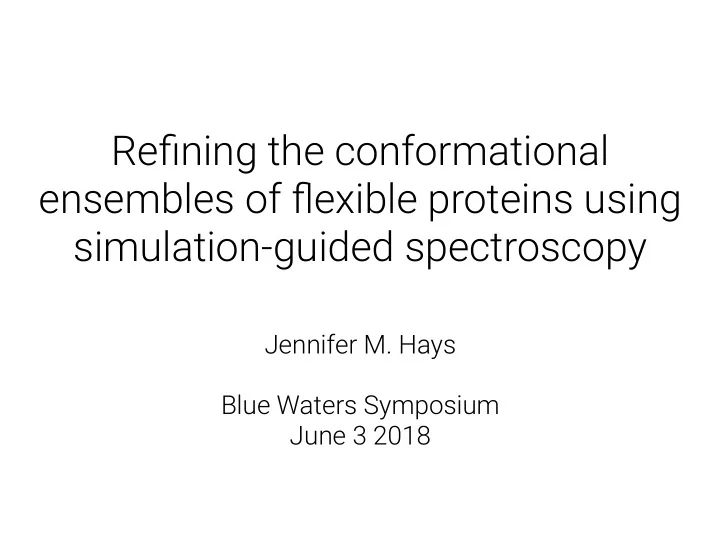

Refining the conformational ensembles of flexible proteins using simulation-guided spectroscopy Jennifer M. Hays Blue Waters Symposium June 3 2018
Acknowledgements • Columbus Lab • Kasson Lab • Linda Columbus, PhD • Peter Kasson, MD, PhD • Marissa Kieber, PhD • Ricardo Ferriera, PhD • Eric Irrgang, PhD • Kenta Okamoto, PhD • Ana Pabis, PhD • Anjali Senger, PhD • Cara Broshkevitch
Flexible proteins are hard to study because many states contribute to their conformational ensembles Information on Information on many degrees conformational of freedom heterogeneity X-ray crystallography FRET DEER MD Simulations
Iterative refinement leverages both computation and experiment Identify I informative experiments t Perform experiments Integrate experimental data using computation
Opa-CEACAM interaction FEMS Microbiol Rev. 2011;35(3):498-514
How we study binding: DEER • Double electron-electron resonance (DEER) provides distance distributions between pairs of spin-labeled amino acids • Great! Captures conformational heterogeneity of Opa ensemble • Problem : DEER only reports on a few DOF in the system, but we need on the order of ~10,000 measurements
Identify I informative experiments t Perform mRMR Algorithm experiments (maximum-relevancy, minimum redundancy) Integrate experimental data using computation b) We want two things from our pairs: 1. maximally informative on the conformational ensemble 2. are minimally redundant with each other Hays et al., Submitted
Identify I Integration of informative experiments t Perform experiments spectroscopic data Integrate experimental data using computation → → a) 31 - 166 88 - 162 → Restart → simulations Ensemble Experimental distribution distribution → Probability . . → Update the pull potential: . → 77 - 107 117 - 107 After 100 ns of simulation per ensemble member (2 μ s aggregate) , Distance (nm) approximately converge to target MD Initial DEER b) Hays et al., Submitted
Identify I informative As a teaser… experiments t Perform experiments A) Integrate experimental data using computation DEER J-S Divergence 2.5 ns 100 ns Probability 200 ns Current method not Time (ns) robust enough to handle well-separated probability modes B) J-S Divergence Come see my poster Probability tonight for more Time (ns) details! Distance (A)
How well-refined are the resulting ensembles? 40 SSP mRMR: 1 st round Inverse J-S Divergence mRMR: 2 nd round 30 20 10 0 85-171 39-176 38-163 33-159 90-172 36-91 23-163 82-166 Hays et al., Submitted
Two rounds of simulation-guided spectroscopy generate a hypothesis for CEACAM engagement Opa loops have three regions of high variability: SV (tan), HV1 (green) , HV2 (red) 0 1 C) SV extended: 40 % HV2 extended: 20 % Multiple loop extensions: 40 % Hays et al., Submitted
A) 28 - 159 (SV - HV2) 80 - 166 (HV1 - HV2) HV2-extended conformations are selected Distance (A) B) during SV THR159 GLU28 CEACAM 45.2 A engagement ASN166 HV2 50.6 A HV1 ASN80 Hays et al., Submitted
Summary • By incorporating optimally-selected I Identify highly DEER pairs into MD simulation, we informative have obtained a conformational t pairs DEER ensemble of apo Opa that suggests experiments clear possible modes of CEACAM engagement • Further re fi nement of the bound ensemble Incorporate • binding experiments to determine Restrained- distributions ensemble which loop(s) CEACAM binds: HV2 into simulations or the HV1/SV interface? simulations • additional simulations +CEACAM
Thank you Questions?
Additional Slides
200 c) a) 0 200 0 2 4 Pair-con fj guration MI d) b)
I Identify highly informative a) High conformational heterogeneity pairs t pairs DEER experiments 1.00 entropy = 162 Opa 31-166 4.64 nats Incorporate 166 31 Restrained- distributions ensemble Intensity into simulations 0.95 simulations 1.00 entropy = 88 4.71 nats Opa 88-162 0.95 0 2 2 4 t ( μ s) Distance (nm) b) Low conformational heterogeneity pairs 1.00 entropy = Opa 77-107 4.45 nats 107 Intensity 0.90 77 1.00 entropy = Opa 107-117 117 4.34 nats 0.90 2 2 4 0 t ( μ s) Distance (nm)
Dimensionality of conformational ensemble 30 20 10 mRMR: 2 nd round mRMR: 1 st round SSP 0 0 2 4 6 8 10 Coarse Fine x10 -5 Information-theoretic coarseness (1- ε )
Recommend
More recommend